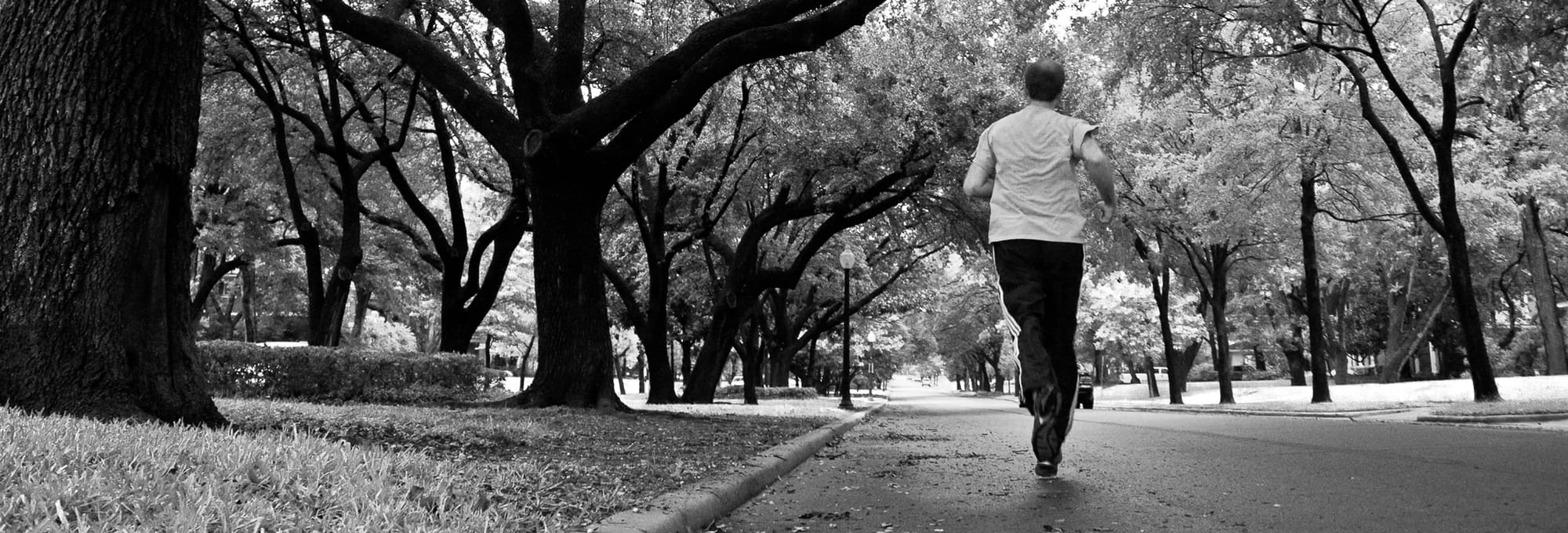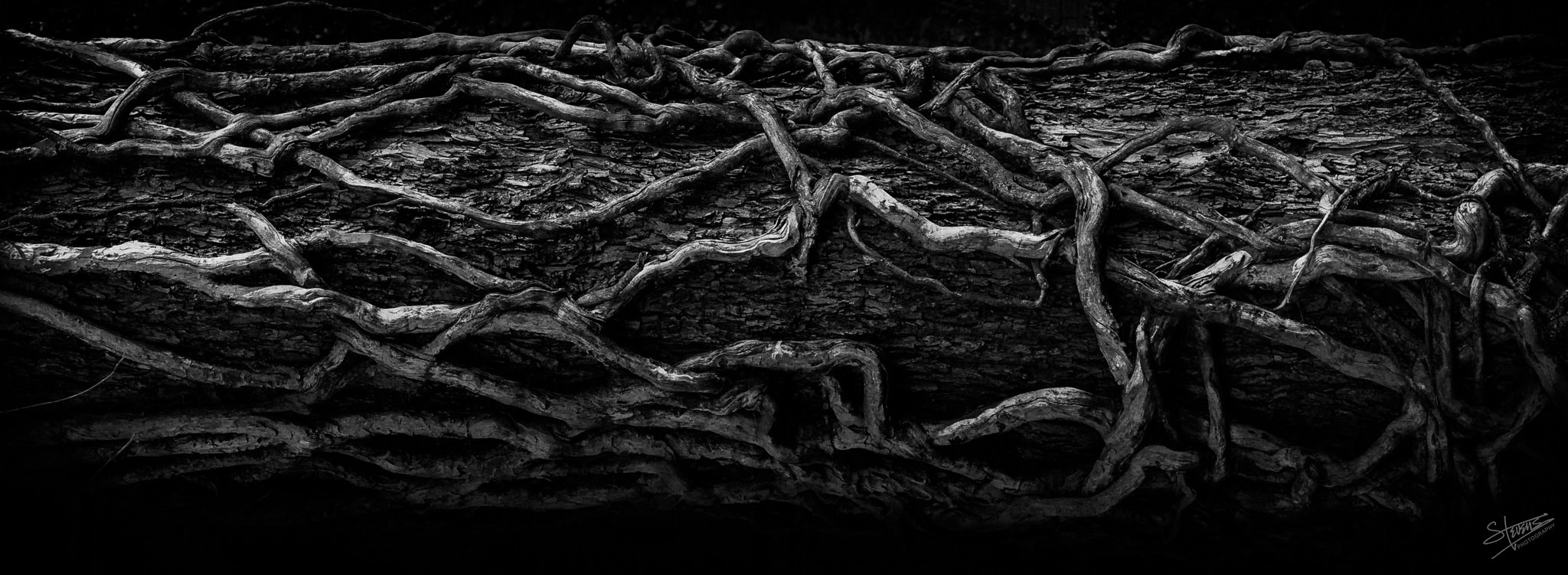The Mile Marker Tree
Twisted and nearly choked by vines, it always told me that I was nearly home.

Cancer recovery is measured in odd units: milliliters of water you can swallow without pain, hours you can keep your head off the pillow, blocks you can walk before the legs revolt. After throat-surgery, fatigue pinned me to a couch for weeks, I set myself a quiet goal: pick up the camera, step outside, and let Swiss Avenue in Dallas be my gym and my gallery. One day I’d stroll a single block, the next I’d push two. Eventually the loop became a ritual — down the boulevard one morning, up the next — until the round-trip totaled almost six miles and my lungs finally stopped keeping score.
The vines still glow silver in the side light, the bark still bears their gentle chokehold, and I’m reminded that recovery isn’t always heroic.
Before I ever met the vine-tree, those first walks felt like rehearsals for a life I didn’t yet trust. The street offered up vignettes as mile-markers: a stained-glass transom catching sunrise like molten honey, the rust-sweet smell of sprinklers striking old brick, a porch swing squeaking out a tentative metronome for my shuffled steps. I logged each detail as a win — a corner turned without resting, a photograph snapped before my arms trembled, a breath of humid air swallowed without wincing. By the time I reached the cross-street at La Vista, the ache in my throat felt less like punishment and more like proof of effort.
On weekends, when traffic thinned and shade pooled like ink beneath the pecans, I noticed how other pilgrims clocked their own progress. A silver-haired jogger tapped her fitness watch at every block; a mail carrier paused to stretch the tendons in her ankles; a teenager practiced the same kick-flip until board and pavement spoke fluent thock. We were an unspoken fellowship of strivers, each borrowing a sliver of resolve from the others’ persistence.
Swiss Avenue rewards that sort of quiet ambition. Its century-old mansions shoulder one another like teammates, every façade a thesis on endurance. Prairie horizontals yield to Tudor half-timbering, then surrender to sudden Mediterranean arches — a polyglot of rooftops keeping a remarkably civil conversation. Walking that architectural cadence felt like leafing through a wordless picture book on fortitude — here is what stands when fashions change, when storms batter shingles, when decades drift past like weather.
A quarter-mile into my route stood a tree that never behaved like the others. Its bark was wrapped in a lattice of woody vines so intricate it looked less grown than hand-woven — an accidental tapestry whose threads twisted, knotted, and doubled back on themselves as though they’d spent decades rehearsing one performance. In a street lined with manicured live oaks and polite elms, the vine-tree felt imported from some older, wilder realm, a sliver of fantasy forest crash-landed in front of a modest apartment house.
I’d pause there whenever I took my camera, trying to decipher the pattern. Daylight skimmed the ridges like side lighting in a studio, throwing micro-shadows that made the vines appear to float above the trunk. Sometimes children passed without noticing; other times a neighbor’s dog broke stride, nose twitching, as if it, too, sensed the shift in gravity. For me, the tree became both waypoint and talisman: reach the vines, and I knew I could finish the day’s walk — maybe even break into a trot for that last stretch home.
Month after month the vine-tree stayed obstinately identical — same gray bark, same knotted lattice, no leaf or tendril betraying the season. Its very lack of drama turned it into a perfect benchmark. Each photo I snapped wasn’t proof of the tree changing but of me changing. One picture marks the week I could finish a single mile without stopping; the next, the morning I tacked on an extra block and arrived home still breathing evenly. Frame by frame, the backdrop never shifted, which made the gains in my stamina stand out with crisp, undeniable clarity.
Back home, I printed a handful of those frames on thick matte paper and pinned them to a corkboard beside my treatment calendar. Lab results lived next door to morning light; prescription dosages shared space with leaf-vein arabesques. The board became a diptych of data and devotion — evidence that healing is never only clinical. It is bodily and aesthetic, relational and shamelessly emotional.
Years later, long after doctors used the word cured without crossing fingers, with health and stamina returned, my daily ritual became less frequent. Then, after a lapse of a month or so, I went out for a run. Nearing the quarter-mile to home marker, I found the apartment house mid-renovation — and the vine-tree erased, not even a stump to show it had ever stood there. The news landed harder than I expected — like hearing an old training partner had moved away without saying goodbye. I slowed to a walk for the remainder of my run. Yet the photograph remains, and in it the vines still cling, still whisper their impossible geometry.
I’ve tried to assign metaphors — healing, resilience, the beauty of entanglement — but none of them quite fit. The truth is simpler: the tree was just a tree, and that was magic enough. It asked nothing, offered no wisdom, merely stood where I needed it to stand while I put one foot after another back into the world. Sometimes a milestone isn’t a lesson or a symbol; it’s a living thing that keeps time with your heartbeat until you’re strong enough to keep time on your own.
Whenever I revisit the image, I feel the early-morning hush of Swiss Avenue, smell the faint sweetness of magnolia on humid air, and remember the first day the walk no longer felt like penance but privilege. The vines still glow silver in the side light, the bark still bears their gentle chokehold, and I’m reminded that recovery isn’t always heroic. Sometimes it’s a camera click in front of a beloved tree that once stood exactly a quarter-mile from home.
And that, perhaps, is the quiet gift of any mile-marker: once you’ve absorbed its lesson into muscle memory, it vanishes. The stretch that once felt impossible becomes invisible background, and your attention is free to roam farther, wider, deeper. Every felled tree, every demolished landmark, leaves behind an outline only you can see — a negative space that urges you forward the way a vacancy in a jigsaw puzzle begs for its missing piece.
Some afternoons I still trace the old circuit in my mind’s eye, letting newer sights audition for the role the vine-tree once played. A swallowtail bush alive with blossoms, the thunk of a screen door catching a breeze, a puddle mirroring the sky after a sudden rain — any of them might, for a season, become the next checkpoint. The object matters less than the act of noticing, of pinning your hope to something outside your own body long enough to realize the hope was inside all along.
What natural landmark do you use to gauge your own progress?
— Lawrence

Thanks for reading Still Stories! Subscribe for free to receive new posts and support my work.

